Every morning, Lewis and I went downstairs and breakfasted in the hotel's dining room. In the corridors, lobby, or garden, we often exchanged greetings with the smiley housekeepers. Unconcerned that we were a gay couple, they liked our affable American charm and readily accommodated our tiniest request. In our global travels, we observed that hotel maids in Italy, England, Finland, China, India, and the Netherlands are much happier than the overworked/mistreated/underpaid ones in the USA... (and Italy is a non-tipping society!) Despite that, we gave gratuities to our friendly Italian housekeepers (seen above).
Mingling with other guests in the breakfast room, our first decision was where to sit. The main room had frescoes circa 1910.
It is augmented by an enclosed patio (with heat lamps).
The room with the buffet had a historic chandelier and plank flooring.
I was enamored with the self-serve orange juice machine. Mechanically, it squished oranges—which were locally sourced from Southern Italy. Alongside it, there was a classy array of decanters filled with juices, bottles of gin, and bottles of balsamic vinegar. The excellent vinegar is worth mentioning because it was famously made in the City of Modena...
...which makes the best in the world, in the neighboring region of Emilia-Romagna. It is perfect when paired with something creamy. Handmade balls of mozzarella floated in a lidded bowl, and I used tongs to retrieve a few. They tasted perfect. When I drizzled vinegar on them, the combination was amazing!
On another counter, there were tiered trays of Tuscan breads: dark wheat, semolina, and chestnut flour. An automatic toaster provided Lewis with the desired darkness.
Platters of cold meats included salami, turkey, and handcrafted mortadella from the nearby City of Bologna (seen below), which makes the best type!
Such things are overpriced as "luxuries" in The States (perhaps encouraging mindless consumers to buy corporate-made "breakfast products"). However, in their homeland, those well-made foods are offered as a free meal to hotel guests. Lined with salt, a dish contained hardboiled eggs... which we enjoyed. A chafing dish offered scrambled eggs, smoked sausages, and steamy amounts of softly charred bacon. We were always content with that.
It was part of Lewis' breakfast, every morning.
A separate counter showcased various yogurts, cereals, and porridge. They were accompanied by carafes of cream, milk, and chilled cartons of non-dairy milk. We liked the walnut milk!
Another counter had viennoiserie and freshly-made tarts. Every day featured a different tart: apricot, ricotta, berry, chocolate, orange, and lemon. Lastly, bowls of pears, bananas, kiwis, and apples ensured guests that they ingested their vitamins.
The cheeriest server that you can imagine greeted us daily, and she offered to fetch whatever type of coffee that we wanted. I usually desired an espresso or macchiato, while Lewis preferred cappuccinos.
Sustainably and humanely raised Tuscan cows provided unadulterated milk that didn't make our stomachs gurgle like (processed/fortified/pasteurized) American milk does. So, we could enjoy real milk/cream, instead of oat milk. Once again, the crest of the Medici family appeared on the porcelain and sugar packets...
During breakfast, we overlooked the tidy garden. An astounding aspect of the Hotel Orto de Medici is that its garden was preserved since the 1400s.
No construction was allowed to occur on that land. Considered almost sacred, that plot of property was the "artists alcove" that the Medici owned. On that exact spot, Lorenzo Medici (a.k.a. Lorenzo the Magnificent) met the teenage Michelangelo Buonarroti. Born in Tuscany, Michelangelo belonged to a family a bankrupt bankers. As his family stabilized, they relocated to Florence (Italy's greatest center of arts/learning), and he was apprenticed to a painter. He also learned how to sculpt marble. In that garden, Lorenzo evaluated the 14-year-old and became impressed with the lad's sculpting talent.
According to the legend, the young artistic prodigy was toiling on a sculpture of the depiction of a fawn deity. Testing the pupil, Lorenzo remarked about the supposed age of the creature, so Michelangelo knocked out some of the marble and chiseled alterations. The abrupt compromise—coupled with the youngster's witticism—made Lorenzo laugh with admiration. Impressed, he hired Michelangelo and gave him valuable tutelage with his master-artisans. From that moment, Michelangelo's innate talents developed... and the world is grateful for his masterpieces. (His sonnets and love poems are also famous—and were aimed at an exceptionally handsome 23-year-old nobleman named Tommaso dei Cavalieri).
Just imagine that Lewis and I began each day in Florence on the hallowed ground where Michelangelo started his illustrious career. It made us swoon!
*That complimentary "breakfast for two" (amidst such historical surroundings) was a great value for €110 per night.
In the lobby, the same bow-tie fellow was stationed at the Front Desk. Guests are required to leave their room keys at the Front Desk, when they go out. As we did that, he remembered that it was our day to see the museums. With a big smile, he drew us maps of where to retrieve our pre-booked tickets, and where the entrances were. (At both places, you buy/retrieve tickets at one place, and you enter in another). We said "Ciao!" and exited through the auto-sliding glass doors. Enjoy the Italian lyrics that accompany my video clip of it...
As we walked, we noticed Florentines pausing at window-counters and espresso bars for more caffeine. We learned that most Italians begin their day with one coffee at home, but after a couple of hours of errands/work, they visit a coffeeshop for their "second espresso of the morning".
Consequently, coffee beans are a significant commodity.
At the designated time, we arrived at the Uffizi (Offices). It is in the historic center of the city, overlooking the river. In 1560, it was built by Cosimo I de' Medici as offices for his government. He also stored his burgeoning art collection in it. (He positioned it adjacent to the Palazzo Vecchio, which was his home, at that time, and where his ducal court gathered). The large U-shaped building is chock-full of portraits, ceiling frescoes, sculpture, and Catholic relics. As part of a UNESCO Site, it is the most-visited museum in the nation, and it has 3,000+ pieces of artwork.
Derived from Grecian values that the Romans copied, the plethora of male nudity was noticeable. As a gay couple, we appreciated that!
Created in 68 AD, this marble/onyx bust depicted a teenage boy who was a Roman (pagan) priest's lover.
The teen's delicate features and long hair demonstrate the artist's skills to make masonry mimic humanity. In life, such boys served their masters during mealtimes and (obviously) bedtime. Impressively, it was socially permissible for them to accompany their masters to religious (animal) sacrifices that occurred in public, as well as private ones paid for by families. Certainly, homosexuality was accepted in those eras, but the presence of cute boys at religious ceremonies was desired because it was believed that their attractiveness was pleasing to the gods.
Throughout the numerous museums, churches, and galleries that we toured, Lewis and I keenly observed an abundance of well-sculpted male nudity that outweighed female nakedness. Specifically, many depictions gave focus on male butts. Erect penises were not depicted because it was considered obtuse to feature an erection in that era since they indicated uncontrolled energy. A flaccid penis on a muscled statue (with a taught butt) indicated a strong mind. It's undeniable that a lot of homosexual "hinting" occurs in Florentine artwork.
I suspect that many of the Medici males admired manly traits. The final male descendant was Gian Gastone de' Medici.
He ignored his wife and his ducal duties, while squandering his ancestral fortune on homoerotic escapades. His male lovers ("favorites") collected unseemly sums from people who craved favors from that final Grand Duke of Tuscany. His most influential lover was Giuliano Dami, who was painted on a ceiling "riding" a stallion with a twinkle of light over his head.
Previously servicing a marquis, he was described as an "exceptional physical beauty". On behalf of the grand duke, he hired numerous young men for their additional entertainment.
Outliving Gian, his childless wife bequeathed his ancestral art collection and properties to the City of Florence, when she died in 1741.
Each of the vaulted ceilings is full of caricatures. Some are half-man/half-beast.
Only keen observers will notice nymphs playing with "weapons of mass destruction".
In those images, notice the half-moon faces exhaling smoke (at the bottoms). Every nook and cranny has something! Perhaps, they were the precursor of vintage comic illustrations?
Lewis admired the girl with braided hair...
...while I admired this portrait of an "educated woman" with books and scholarly scrolls—in an era when women were not given equal opportunities. Clearly, she was significant.
Medieval clothes were certainly colorful!
Looking closely, we saw details from the 1540s that amazed us!
This statue seems to be doing Disco dancing! Ha ha!
The museum's windows provided attractive views, too.
Even though ancient Romans were polytheistic, their depictions and artsy creations were still valued by the Roman Catholic Church—which was notoriously/murderously intolerant of pagans and other religions. That is a double-standard. Read more about that phenomenon here:
https://halfwindsorfullthrottle.blogspot.com/2016/12/the-gods.html
On the topic of papal atrocities, there was an exhibit on Dante's Inferno, which he started writing in 1308. Illustrated copies of the 700-year-old book were displayed (sorry, no photography was allowed). There were several rooms that explained the circles (levels) of hell that Dante invented... and which public figures he put in them.
We reached the rooftop cafe exactly as the clocktower of the Palazzo Vecchio chimed mellifluously for 12 o'clock! Perfect timing!
It was glorious to hear those old bells. In America, most church bells are silenced via Noise Ordinance laws because ignorant Americans uncaringly perceive them as a nuisance. Thus, we were always enraptured to hear bells chiming the time in Italy. Turn the sound on for this video...
In the distance, we also heard the cathedral bells chiming to announce the time.
Their synchronized ringing signified that it was time for our lunch. Fortunately, the alley to the restaurant was downstairs from the museum. As we entered Degusteria Italiana, the candles of a five-arm candelabrum flickered. We sat under a sparkly crystal chandelier. We admired the redbrick walls—covered by wine racks—and the see-through kitchen, encased in brass-framed glass. We were able to watch the chefs prepare haute cuisine.
The tricky part was washing my hands in the lavatory. The handles on the antique sink were non-functional. I couldn't figure out how to turn on the water. Eventually, Lewis solved the mystery; foot pedals activated the water. (I think the owner should put a sign to inform his clientele).
Our waitress gave us the most professional service that was possible. (Even though Italy has a non-tipping society, her professionalism prompted Lewis to give her an additional gratuity of 10%, which is the national norm for that situation).
From the extensive wine list (which included something from every part of the Italian peninsula), Lewis selected a bottle of Vernaccia di San Gimignano. It was made in a Tuscan town named San Gimignano, which had a settlement since 3 BC. This is the town's coat of arms.
As a fan of "wild game", I ogled their menu that included venison, quail, and partridge... but I could not entice Lewis to try some. Instead, he ordered beef tartare, which was loaded with freshly-foraged black truffles from Norcia (in the province of Perugia).
Fresh from the oven, we were given a loaf of Tuscan bread, enshrouded in a precisely-folded towel. Enamored with mortadella from Bologna, Lewis selected a plateful, and it was even better than our hotel's. From the Cheese Menu, we got a sampling of bleu cheeses: cow, goat, and sheep's milk.
The sheep and goat's milk cheeses were produced in Tuscany. The cow's milk cheese originated in Apulia (Americans call it Puglia), which is the "heel" of Italy's "boot".
We also ate handmade fettuccini, topped with a generous portion of shaved tartufi neri (black truffles) from Tuscany. Tuscany is one of the best regions for harvesting those elusive fungi, so we were repeatedly delighted to eat them on our meals. Prices for them were vastly lower than at any eatery in the USA.
As we departed, the well-mannered server ignored the ringing telephone so she could open the door for us as we left. We exchanged a cheery "Grazie."
As savvy travelers, we arranged our museum reservations to give us 2.5 hours between them. As typical overworked Americans on vacation (who only get 3 weeks of vacation per year, while Europeans get 6+), it was reasonable to have a luxurious two-hour lunchtime.
As we strolled to the Pitti Palace, we looked up to admire the Vasari Corridor, which is a "secret passageway". Made famous in the best-selling novel, Inferno (by Dan Brown, who wrote The Da Vinci Code), it was constructed in 1565. It was named for its designer: Giorgio Vasari.
Yet, it was solely intended for Cosimo I de' Medici. The elevated "private walkway" connects two of the Medici palaces, and the ducal family used it to avoid attacks. Starting at the Palazzo Vecchio...
The palace has an illustrious history, but the Medici made it famous when they used it as a home to signify their increased power. As the Medici Bank grew in prominence, it gained powerful clients. It managed the ill-gotten funds of popes and the King of France. When a member of the Medici family became Pope Clement VII (leader of all Christendom), he anointed Alessandro de' Medici as the Duke of Florence in 1532. Florence was instantly transformed from a republic to a duchy.
Alessandro was the first Medici to rule Florence as a hereditary monarch.
In 1859, Tuscany was captured by Victor Emmanuel II, who was crowned as the first King of (Unified) Italy. The Habsburgs returned to Austria.
Arriving at the Palazzo Pitti, Lewis and I were awed by the size and severity of its design.
Erected in 1458 (for a Florentine banker named Luca Pitti), the block-style exterior belies the extravagance inside. In 1549, Cosimo I's wife bought it, and Cosimo hired Vasari to double its size. After the Medici dynasty ended, the Grand Duchy of Tuscany went to an Austrian named Francis I. He was the Holy Roman Emperor and Duke of Lorraine.
When Napoleon Bonaparte temporarily ruled Italy as its king, he resided in the palace.
In 1860, the House of Savoy became the Italian Royal Family, and they owned it as a royal residence.
That was the first unified Italy.
The royals named Florence as the capital of Italy until 1871! In 1919, the last King of Italy gave the estate to the people. (His tolerance of fascists—that made Italy into a dictatorship and a Nazi ally in WWII—compelled the people to dethrone him in 1946 and abolish the monarchy). The palace is part of the city's UNESCO Site.
Lewis and I were grateful to have reserved tickets. Even though February is considered the "low season" for tourism, plenty of Italians visit Florence for overnight excursions or day-trips. In the photo below, the long line on the left was for people to buy admission tickets. With our reservations, we used the door on the right... which had no line.
The palace captivates visitors with 500+ pieces of art, ranging from the Renaissance until the 18th-century. First, we saw the ballroom with handblown Murano chandeliers from Venice. (Years ago, I visited Venice—a UNESCO Site—and toured the Murano workshops to watch glassblowing).
In "Mediciean times", the room was named the "Chamber for Cardinals and Foreign Princes". It was refurbished for Grand Duke Fernando I Medici (1549-1609). His son, the Grand Prince used it as a drawing room to draw his guests together. The intricate stucco was added in 1776, during the time that the United States was fighting its Revolution of Independence. Every detail of the plasterwork is utterly awesome! Notice each curled petal, coffered cube, and the bunches of grapes!
As we progressed through the palace, we glimpsed the 11-acre formal gardens through the antique windows.
Despite its size, the Boboli Gardens have a naturalness that resembles Central Park more than a royal garden. That was the style in 1580, and it was preserved.
Since the garden is dormant in winter, we did not buy the additional tickets to walk through it. We remained content with the dozens of chambers in the palace. Exuberant displays of Renaissance, Gothic, Baroque, and Rococo designs filled each one—from floor to ceiling.
Another example of detail is in this painting of Napoleon. As the main character, he occupies most of the canvas, but he is off-center. Everyone is shaded, but light illuminates a cute young man. Clearly, the artist thought he was cute, and highlighted his alluring attractiveness and his "come hither" stare!
Admittedly, Lewis and I started to feel as if each room—crammed with art—began to resemble the previous one.
Viewing the Uffizi and Pitti in the same day might be an overload of culture. Nonetheless, gratitude is given to the workshops of the Opificio delle Pietre Dure which is a global leader of art restoration. Based in Florence, it is part of the Ministry for Cultural Heritage, and it protects those treasures.
Exiting the palace, we returned northward over the bridge.
It was that "quiet time" of the afternoon when Italians pause and congregate to refuel on good vibes.
We casually meandered the tidy streets. We loved the lack of vehicular noise on the pedestrian-only streets. The milieu was enchantingly tranquil and pretty. We were enclosed in a soothing peace—a calm of beauty. With small serene smiles, we slowed our pace and breathed deeply—inhaling the smells of chocolatiers, cafes, and perfumeries.
*To see my amazing university experiences, please use this link:
https://halfwindsorfullthrottle.blogspot.com/2013/05/college-memories.html
Eventually, we reached a district of Asian markets. Unlike Milan, Florence does not have an official Chinatown. Asian restaurants are sprinkled throughout the city, but a cluster of Asian markets exists near the train station. We shopped in two of them, and Lewis was impressed to hear the owners conversing in fluent Italian, as well as Mandarin. (Nobody spoke Cantonese). We were also impressed to see a large amount of Caucasians buying Asian ingredients. That is not something we see in American Chinatowns. Lewis purchased several packages of savory snacks and a bottle of coconut water.
We deposited those goodies in our hotel room, and then we savored the sunshine on its courtyard terrace.
Back in New York, typical gusts of wind (more than the "windy city" of Chicago gets) threatened to break NY's feeble infrastructure and decaying power-lines.
After freshening ourselves, we ventured to a seafood restaurant named Fishing Lab. It was a reasonable walk from our hotel, and we enjoyed the mild evening. It is located on Via del Proconsolo, which is a street laid on the first circle of ancient Roman walls. It is named for the Judges & Notaries of the old Republic of Florence.
The staff was inside, but they don't unlock the glass doors until the precise time.
We understood that logic. So, we drank cocktails at a nearby bar inside the Bernini Palace, as seen below.
It was a great way to start our Friday night! I requested a Manhattan, and the bartender used sweet vermouth produced by Martini & Rossi. Founded in Italy in 1863, the distiller was so excellent that it was awarded a Royal Warrant to supply the Italian royal family. Continuing today, the company proudly adorns the labels of its millions of bottles with that insignia.
Wearing sneakers made by Valentino (an icon of Italian fashion), Lewis was stylishly ready for Aperitivo Time in Italy!
Looking up, we spotted a series of female faces peeking from the perimeter of the room. They all wear "Florentine straw hats", which were produced locally since the early 1700s. Florentine wheat produced a high-quality straw that was woven and braided into fashionable hats for ladies and gentlemen.
From our seats, we also peeked through the window and saw the Duomo illuminated at night.
At last, it was time for the restaurant to open, so we returned. Without a reservation, we were fortunate to get a table-for-two. The interior has a sleekness that contrasts with his medieval origins.
Charitably, the paper placemats were illustrated by an integration project for young people with disabilities: L'incontrario. That was heart-warming.
Unlike the typical Italian rules about eating, the menu is casual and allows customers to choose whatever they want in any order.
We ordered an assortment of "small plates" to share—starting with arancini balls that were cleverly served in an egg carton.
Since it was "Fry Day", we had fried shrimp & calamari with chips. The batter was crispy and cooked in a fresh batch of oil.
We each had a €2 grilled jumbo prawn, which was a great value.
Next to us, a table of Czech women ordered the seafood stew to share as their main course. We copied them. It was presented in a large bucket with a ladle. It was chock-full of mussels, squid, clams, shrimp, sausage, and white fish... and it was lined with Tuscan bread that used to soak up the yummy broth.
To prove Florence's affordability, that entree only cost €16. The bucket was 10-inches hight and the bottom was loaded with pieces of sausages and fillets of fish. It was an amazing bargain.
Equally indicative, when Lewis went to a supermarket to buy two extra-large bottles of water, the total cost was only €1.78!
Since most seafood restaurants don't offer large dessert menus, it was another opportunity for us to eat the treats that we had in our room. Lewis uncorked a bottle of Prosecco (Italian sparkling wine). We matched it with cheese—which is a very European form of dessert—and then cookies.
In the morning, it was gratifying to see that the moderate temperature in Florence was 56-degrees, while New York suffered 28-degrees... despite a similar latitude!
Our day started with another mouth-watering breakfast. The beverage server greeted us with another musical-sounding "Buongiorno!" We reciprocated! Lewis and I drank freshly-ground macchiatos and freshly-squeezed orange juice.
We visited a weekend Flea Market that occurs in an 1845 park called Piazza della Indipendenza. Every part of the square was lined with sellers' tables tents, and all types of citizens sell things at a wide range of prices. Everything imaginable was for sale. Toy cars, andirons, antique clocks, Art Nouveau chairs, seashells, teapots, candelabra, bookends, silver bowls, sugar shakers, sugar cube tongs, letter openers, lamps, porcelain, figurines, vintage postcards, records, copper basins, picture frames, knickknacks, gimcracks, and bric-a-brac.
Despite the bargaining and commerce, the city keeps the area clean and tidy with street sweepers that patrolled the pavement.
From there, we moseyed to the Piazza della Unita Italiana and admired a garbage truck behaving like the ones in the Kingdom of the Netherlands. To keep the city clean and deter vermin, trash is put in receptacles that have underground containments. Garbage trucks have mechanical arms that uproot each trashcan and dump the contents into the truck. Then, it reinserts the tall trashcan into the ground. Nobody has to touch the garbage.
Residents avoid touching the trashcans, too... using foot pedals to open them. Innovative and sensible! They are all over the city, which is helpful.
Neighborhoods also have these types of trash receptacles.
*NYC is the filthiest city in the world, but it continually resists investing in garbage containment. Uncaringly, it lets trashcans spill-over with smelly garbage.
Even the trashcans are filthy and neglected! NYC's grossly overpaid Sanitation employees ($100,000+ annually) don't keep their city clean. Click on this image to make it bigger/clearer.
Containment would solve the overpopulated city's vermin infestation and trashy stench, but neighborhoods (rich and poor) continue to pile garbage bags on the sidewalks. It is an eyesore.
It was only 10am, yet we observed locals pausing at Wine Bars to get a glass of locally-made wine, sip it, chat with other people, leave their empty glass on a shelf, and depart. In America, wine bars are upscale bourgeois places. In Italy, they are as common and uncomplicated as espresso bars. I suppose that imbibing a small amount of wine at 10 o'clock keeps people youthful.
On the topic of wine, Florence is dotted with leftover "wine holes" in the walls of some medieval buildings. Those little doors were the world's first "drive-throughs"! Florentines purchased/served glasses of wine through those openings. It was fun for Lewis and I to find them in random buildings as we meandered through the city. Some were converted to mailboxes or eye-catching store windows. Most were preserved but sealed.
We walked across the metropolis to have lunch at Ditta Artigianale & Hario Cafe (as recommended by that waitress). We prefer to avoid touristy places, and we like suggestions from locals about places that they enjoy. The cafe is definitely worth it! It occupies a corner-property on a quaint plaza in the Sant' Ambrogio neighborhood. It is alongside a church.
The interior was modernized, yet the space honors its historic architectural elements.
It has a garden courtyard, but that was occupied by smokers.
Having researched the place online, I knew to find available seats in the back room—which is the prettiest. Luckily, we got the last table.
Wearing jeans, vest, and jacket, the manager treated his customers as if they were eating at a grand hotel. He greeted everyone with a typical mellifluous "Bongiorno!" We could see that people liked him; they patted him on the back, hugged him, and he shook hands, grasped arms, and waved profusely. There are two coffee bars: one by the entrance, and one in the back room. That ensures that people get their drinks promptly. Four servers—equipped with e-tablets took everyone's order... or some customers lined up near the entrance to place orders with the counter-girl.
Whereas American baristas expect you to wait within earshot to retrieve your coffee when they call your name, Italian baristas invite you to have a seat (indoors our outdoors), and they bring your coffee to you. American baristas expect you carry your dirty dishes to them when you're done. Italian baristas have a mentality that you are the guest, so you leave your dishes, and they clear the tables. American baristas expect gratuities of $1-2 per drink. Italians live in a mostly non-tipping culture; they do their jobs courteously because it is the correct behavior.
The only time that customers linger by the barista is when they desire a quick espresso—which they keep on a narrow counter (as seen below). Consumed in a few sips, it is finished quickly, and those clients depart with a cheery "Grazie! Ciao!"
Furthermore, American coffeeshops use disposable paper cups, which accumulate in trash bins. Thankfully, Italian ones use (warmed) porcelain cups, so drinkers enjoy a warm tactile sensation. It was nice to see men using them; their manhood is not challenged by the notion of using dainty small-handled cups and tiny spoons. Just like in England, every warm drink is presented with a cup, saucer, and spoon. It is inconsiderate to leave the dirty spoon on the table; use the saucer. Some people hold the saucer to keep their cup handy... with a biscuit on it. The cups/saucers at Ditta were large enough—and off-centered—to keep biscotti on the saucer... for dunking.
Like the locals, we started with Negroni cocktails, which came in chunky glasses that were a pleasant handful to grasp. It was only 3 o'clock on Saturday, but it was the customary thing to do: a celebratory gesture about being alive. A native of the region told us that customers do not give tips to bartenders. They might round-up to the nearest Euro, but that is the extent of tipping. As such, Italy is another country where drinking and eating "out" is more affordable than within the USA.
There was no rush to order our food; the servers seemingly encouraged us to take our time and enjoy ourselves. (Espresso bars and wine bars are where folks sip-and-go, but cafes are where they linger). Much different than American coffeeshops full of silent people studiously working on their laptops, that cafe was full of vibrant conversations and socializing. Nobody brought their laptops, except for two expats. People chose to commiserate, instead of toil on their small screens. They weren't addicted to using electronics that caused sensory distraction; they only used their phones to access the cafe's menu. That is Life/Work balance.
For lunch, both of us ordered crab rolls, which came with sweet potato fries. The bun was perfectly toasted, and the filling involved a lot of crabmeat. Dutifully, the manager paused at our table to make sure that we liked our food. We ordered a bottle of Italian mineral water, produced by Filette (founded in 1894).
Afterwards, I went to the front room and examined the display case to choose some dolci to conclude our meal. Helpfully, our waitress followed me, so she could input my selections on her tablet. I chose a slice of carrot cake (the cake was new and unsliced).
At 4pm, we suddenly noticed that the cafe emptied. Florentines are relaxed yet punctual. Leaving the convivial hubbub of the cafe, we crossed the city to explore the Salvatore Ferragamo Museum. It is at the Piazza Santa Trinita.
Interestingly, the plaza got its name in 1911 from the recommendation of the city's mayor: a Marquis named Filippo Corsini, who belonged to an ancient family. The family continues to be Princes of Sismano in Umbria, and they are credited with modernizing farming in Umbria and Tuscany.
(Another marquis, Piero Antinori, resides in Florence in his ancestral palace, built 500 years ago).
Aside from the Basilica of Santa Trinita, the most notable building is the 14th-century Palazzo Spini Feroni... which is now Ferragamo's headquarters (and museum). (The palace's origins are from 1289!) It was the city's largest private residence.
Like many medieval and Renaissance-era palaces, it looks severe. Based on residential towers of the Middle Ages, palazzos were haughty ways of protecting wealthy inhabitants against anyone who might threaten their lives or power. The exterior has rusticated stones, iron bars crisscrossing over the windows, and massively imposing doors.
In 1938, the company's namesake founder purchased it. The company's recognizable logo originated from the palazzo. In the 1960s, Mr. Ferragamo's daughter admired the antique iron hoops (for tethering horses) that hung from the exterior...
...and she made that the brand's logo. The logo appears on the pair of suede loafers that I own—which I purchased more than 10 years ago. They are still in excellent condition: a well-made shoe!
*I owned 6 pairs of Italian-made shoes, and half were from Ferragamo.
Relatedly, the facades of medieval palazzos have two other types of ironwork. As pictured below, the holder on the left was for banners/flags, and the one on the right was for torches at nighttime. Each palazzo housed the noble family, servants, and the family's courtiers—like a mini-kingdom. Being a mercantile city, merchants often visited those homes to ply their trades. Thus, many horses were tethered to all sides of the building. Nonfunctional nowadays, those metal items are still carefully preserved by building-owners as pieces of history.
On the topic of history, we entered the museum.
The museum was opened in 1995. Located in the lower level, it chronicles the company's history, starting with avant-garde shoes for women. Salvatore only made bespoke men's shoes for celebrities, such as Lawrence Olivier and the Duke of Windsor. Similar to Frank Lloyd Wright, he was "ahead of his time". His styles seem like they were created in the 1970s, yet they were fabricated in 1939-1947! That era was during the Great Depression and World War Two, yet his creativity achieved greatness.
The museum also highlighted the company's inspirations for scarves: using ancient Japanese, Chinese, and Indian motifs. Having visited those countries to appreciate their cultures, we agree with their choices!
Looking up, we noticed the medieval ceilings, too!
Upstairs, a salesman noticed us browsing the merchandise, and he gallantly gave us a full explanation of each collection. He deduced that we did not intend to buy anything, yet he wanted to share the grandness of the brand. It was like getting a complimentary tour, and that impressed us. Currently, Ferragamo remakes pairs of its famously-worn historic items: shoes and handbags. So, you can pre-order a replica of a handbag used by Princess Diana in the 1980s or a pair of shoes worn by Marilyn Monroe in the 1950s. That is a nifty concept.
Completing a full circuit of the flagship store, the salesman ushered us to the exit. Every employee that we passed wished us a pleasant evening: "Buona Serra!" Outside, the daylight faded and dusk approached, yet that shopping district remained active.
Crossing the 16th-century Saint Trinity Bridge, we encountered groups of friends gathering before starting their night.
We proceeded to the San Frediano district and intended to dine at the city's most-popular Japanese restaurant: Momoyama. However, when we arrived, we realized that the dining room did open until 7pm, and its bar remained closed until that time, too. Not to be put asunder, we found another bar.
Floreal had a tropical theme, with mambo music in the background.
Except for another couple, the place was empty. The bartender seated us near a window and gave us menus. Lewis chose a mezcal cocktail. Seeing their sizable assortment of whiskies and vermouths, I requested a bourbon Old Fashioned with muddled fruit. Both libations were lovely.
Seeming to be very fancy for her job, our waitress wore €600 studded sneakers by Valentino! Style is important to every Italian, regardless of their career. Clearly, servers in Italy earn larger paychecks, too.
At 7pm, the bar seemed to suddenly fill with customers! It was as if a bus deposited all of them at once.
That type of phenomenon occurred many times during our trip. Apparently, we had arrived early for the customary Aperitivo Time. Consequently, we arrived early for Dinner Time, but that helped us get one of the few tables that the restaurant set aside for walk-ins (without reservations).
Opened in 1998, Momoyama is a two-level restaurant that looks entirely modern. American music played in the background. We assumed that Japanese sushi chefs were employed, but everyone else was Italian. Our waiter was unfamiliar with the wine list, so the pleasant bartender discussed it with us. Lewis selected a Soave, which is fermented with Garganega grapes grown in volcanic soil. Their slogan is "A little luxury for everyday". The wine's color matched the golden paint on the walls.
Almost exactly at 8pm, the restaurant filled up to capacity. We couldn't believe how timely everyone was! The three other tables for "no-reservations" got occupied by a trio of Brits, a pair of American "millennial" girls, and a pair of Frenchmen. Our food was more interesting than their conversations. We ate sashimi, several sushi rolls, charred pork belly, sautéed vegetables, zucchini blossom tempura, and broiled shrimp coated with squid ink. It was wonderfully tasty.

After finishing the wine, we sauntered along the river and zigzagged through the winding streets towards our hotel. The air was mild, yet sidewalk cafes used flaming outdoor heaters. Most cafes were full of people.
The Venchi Chocolate Shop was mobbed with clients.
We arrived at the Piazza della Repubblica, and saw the carousel illuminated prettily. The square was bustling with people going out for dinner, digestifs, and after-dinner strolls. We entered the famously elegant Gilli Cafe. Founded in 1733, it is the oldest cafe in Florence.
Looking classy, the waiters wore white liveries, and the employees behind the counters wore uniforms of white shirts, ties, tie clips, and blue blazers with white piping.
Very classy, indeed. In the USA, you would expect such uniforms to signify exorbitant prices. Not in Florence. The cafe provides elegance without a surcharge.
Since it was late-winer Carnivale season, bakeshops sold Florence's traditional Carnivale cake. The moist cake is made with an ancient grain and covered with powdered sugar, which is overlaid with a dusting of cinnamon in the shape of the city's emblem. The batter is scented with orange and vanilla. We bought a slice, and liked it.
Yet, I liked the candied chestnut better! Chestnuts are a trademark delicacy in Tuscany, just like truffles. When it's the season for them, they are happily included in all types of concoctions.
We also shared a slice of dense chocolate cake.
Lewis bought a few scoops of gelato in a cone, and he licked it as we walked.
Soon, we found ourselves outside the Duomo again. Its plaza pleasantly resounded with happy laughter and socializing. A few street-hawkers peddled souvenirs, but the ever-present policemen discouraged any aggressive selling.
Returning to our hotel room, we overheard lively chatter from the street below. Lewis peeked down (like the dukes in the Vasari Corridor) and saw revelers clustering at the wine bars and restaurants on the street.
Instead of the noise that we hear at home (thumping car stereos, drag racing engines, screaming students, cursing thugs, and shrieks from mentally-ill homeless people), we only heard cheery words such as "Ciao ciao!" and "Buona Notte!" People sometimes spoke loudly, but it was due to enthusiasm—not rebellious angst.
Contentedly, we drifted off to dreamland. Join us in the next part for more adventures. Ciao for now!























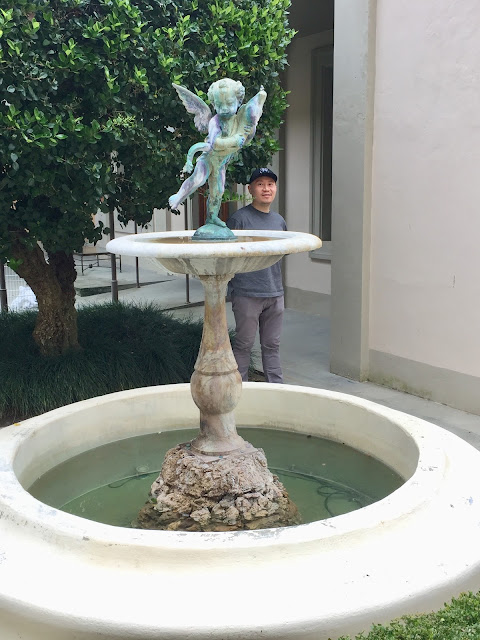













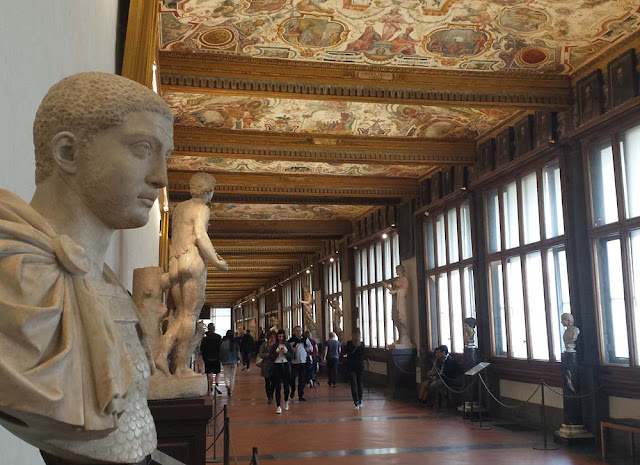











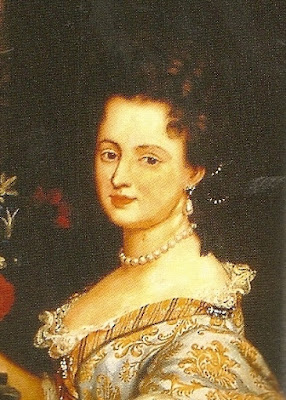
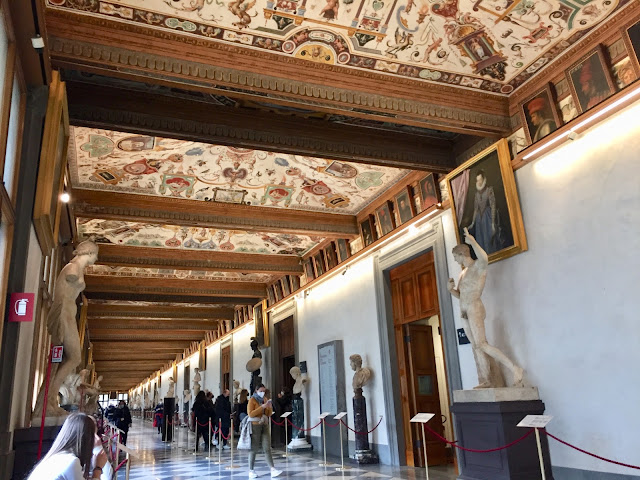






































































_crowned.svg.png)
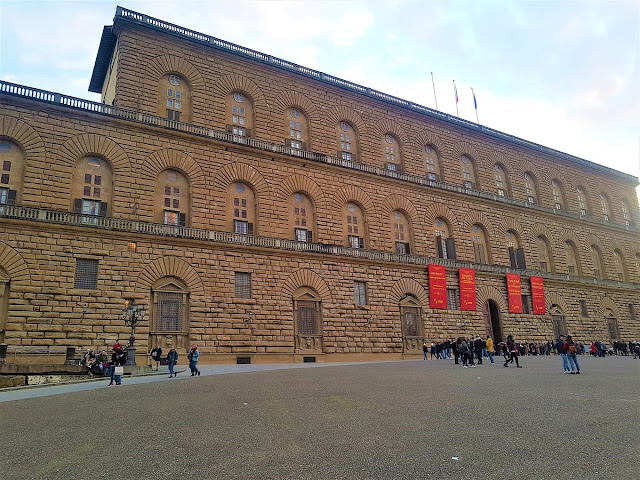















.svg.png)




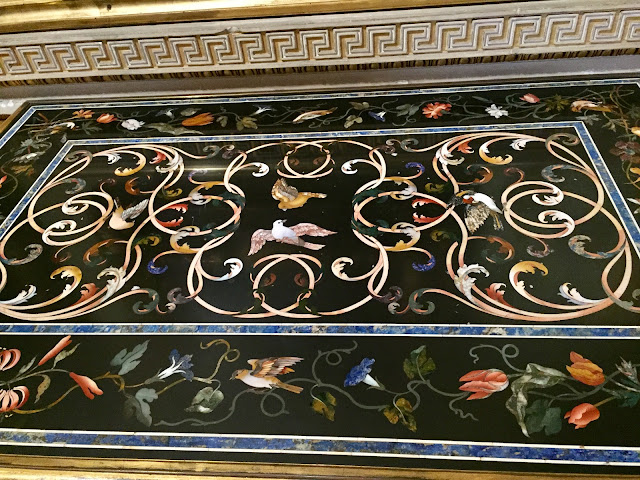
















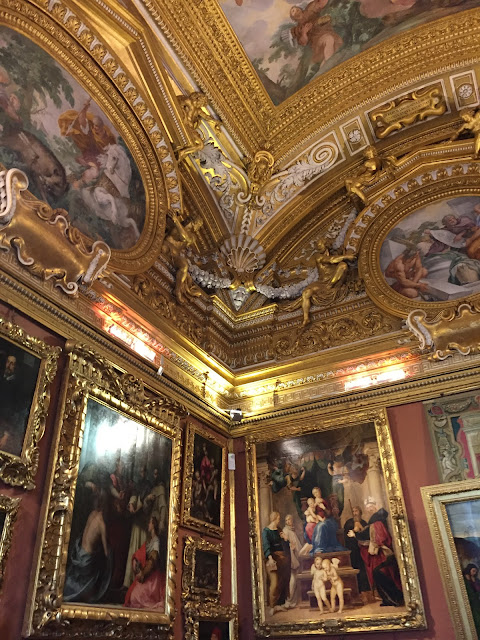







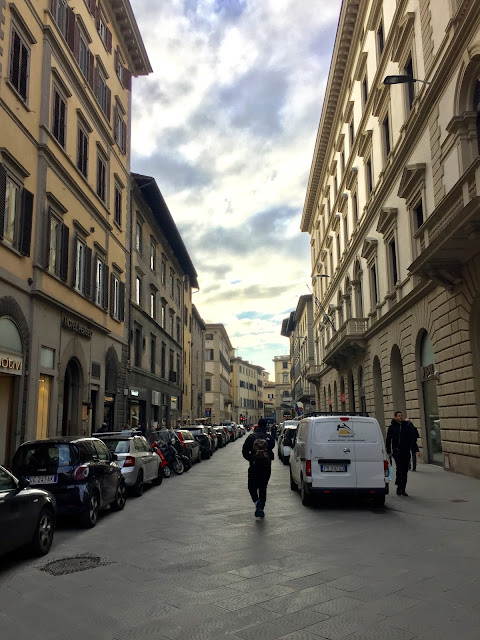


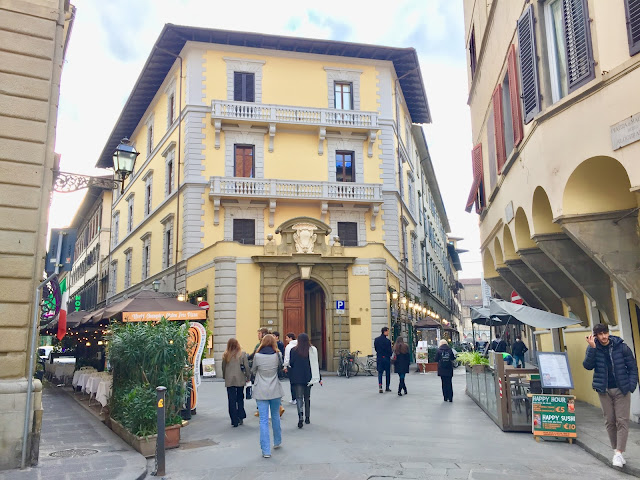



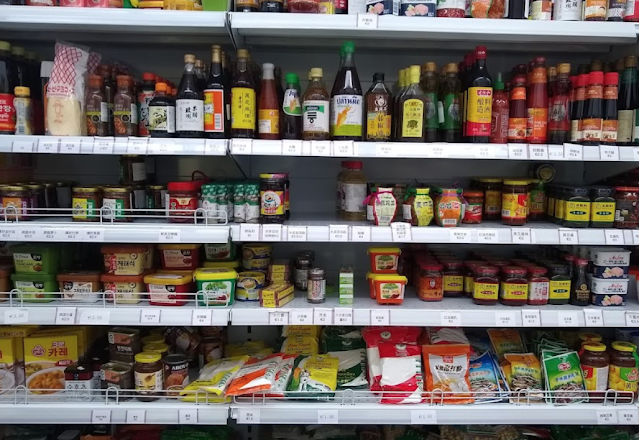








































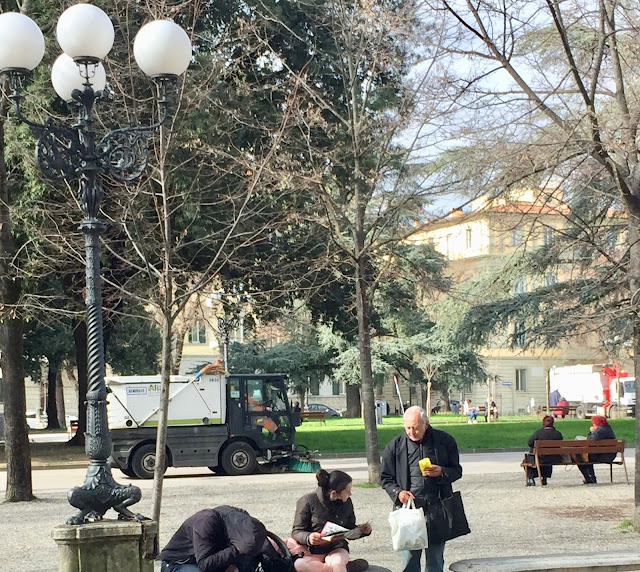









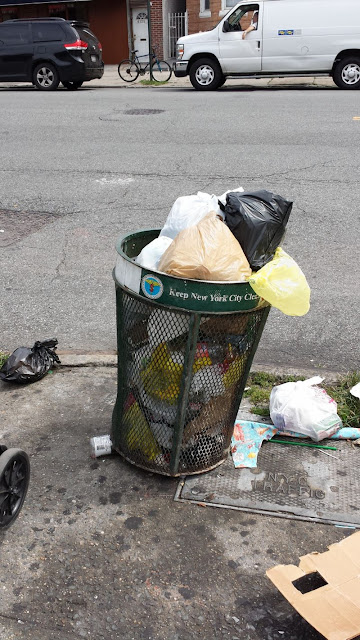

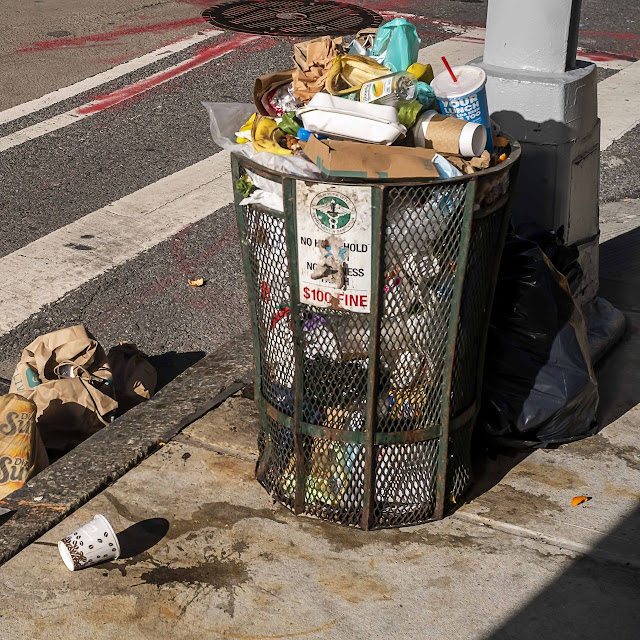












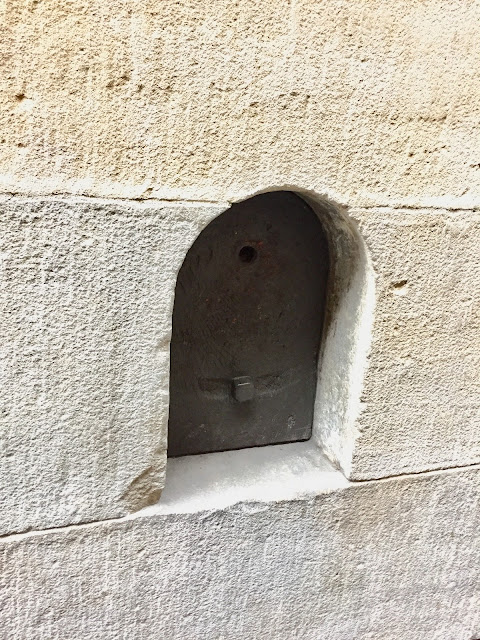














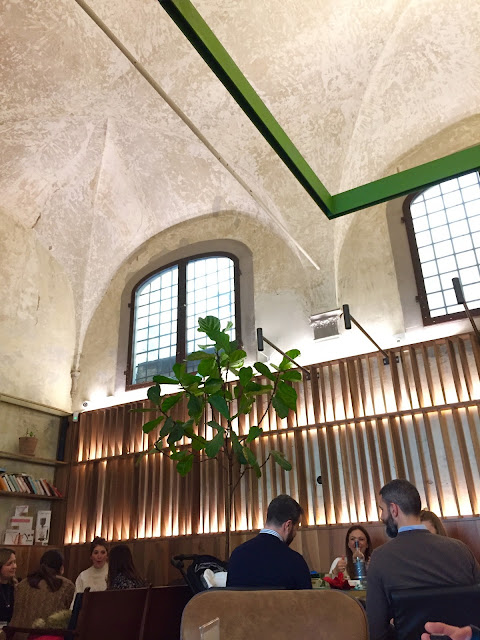




























































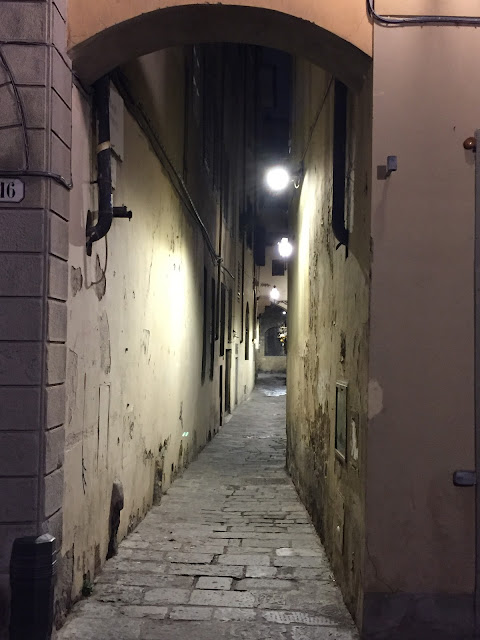






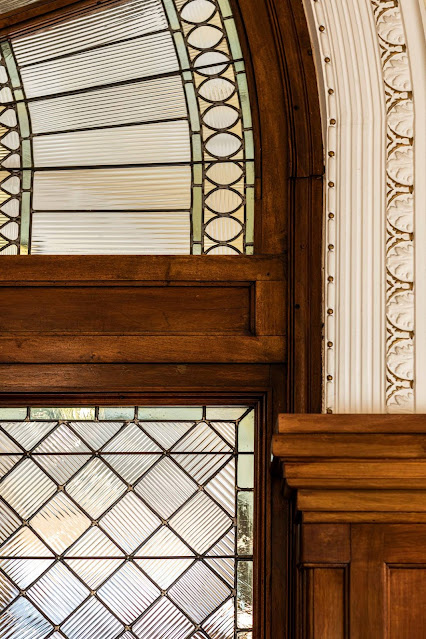














No comments:
Post a Comment
Don't be shy: leave your comments :)